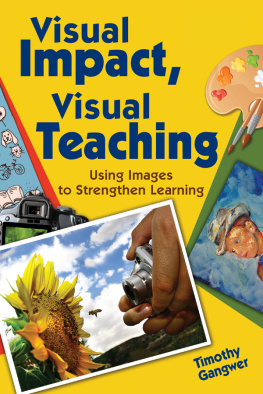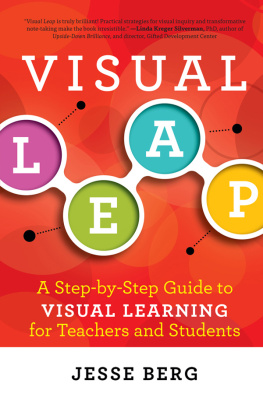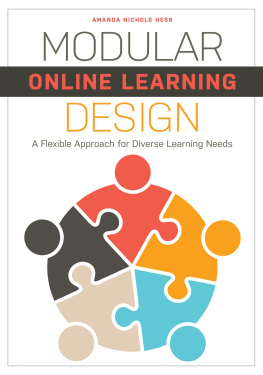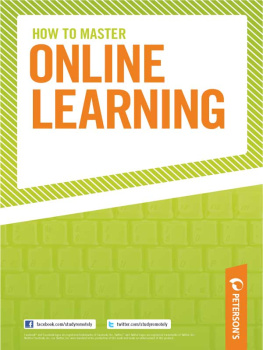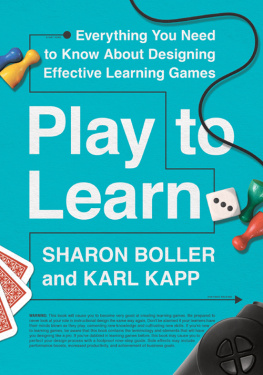Table of Contents
Pages
Guide
List of Illustrations
- Chapter 1: How Do I Begin?
- Chapter 2: How Do I Include Images and Video?
- Chapter 3: How Do I Facilitate Instruction and Interaction?
- Chapter 4: How Do I Integrate Multimedia?
- Chapter 5: How Do I Visually Design a Course?
- Chapter 6: How Do I Support Learners Online?
List of Tables
- Chapter 5: How Do I Visually Design a Course?
Jossey-Bass Guides to Online Teaching and Learning
Visual Design for Online Learning
Torria Davis
Copyright 2015 by John Wiley & Sons, Inc. All rights reserved.
Published by Jossey-Bass
A Wiley Brand
One Montgomery Street, Suite 1000, San Francisco, CA 94104-4594www.josseybass.com
No part of this publication may be reproduced, stored in a retrieval system, or transmitted in any form or by any means, electronic, mechanical, photocopying, recording, scanning, or otherwise, except as permitted under Section 107 or 108 of the 1976 United States Copyright Act, without either the prior written permission of the publisher, or authorization through payment of the appropriate per-copy fee to the Copyright Clearance Center, Inc., 222 Rosewood Drive, Danvers, MA 01923, 978-750-8400, fax 978-646-8600, or on the Web at www.copyright.com. Requests to the publisher for permission should be addressed to the Permissions Department, John Wiley & Sons, Inc., 111 River Street, Hoboken, NJ 07030, 201-748-6011, fax 201-748-6008, or online at www.wiley.com/go/permissions.
Limit of Liability/Disclaimer of Warranty: While the publisher and author have used their best efforts in preparing this book, they make no representations or warranties with respect to the accuracy or completeness of the contents of this book and specifically disclaim any implied warranties of merchantability or fitness for a particular purpose. No warranty may be created or extended by sales representatives or written sales materials. The advice and strategies contained herein may not be suitable for your situation. You should consult with a professional where appropriate. Neither the publisher nor author shall be liable for any loss of profit or any other commercial damages, including but not limited to special, incidental, consequential, or other damages. Readers should be aware that Internet Web sites offered as citations and/ or sources for further information may have changed or disappeared between the time this was written and when it is read.
Jossey-Bass books and products are available through most bookstores. To contact Jossey-Bass directly call our Customer Care Department within the U.S. at 800-956-7739, outside the U.S. at 317-572-3986, or fax 317-572-4002.
Wiley publishes in a variety of print and electronic formats and by print-on-demand. Some material included with standard print versions of this book may not be included in e-books or in print-on-demand. If this book refers to media such as a CD or DVD that is not included in the version you purchased, you may download this material at http://booksupport.wiley.com. For more information about Wiley products, visit www.wiley.com.
Library of Congress Cataloging-in-Publication Data
Davis, Torria, 1966
Visual design for online learning/Torria Davis.1
pages cm
Includes index.
ISBN 978-1-118-92243-9 (paperback), 978-1-118-92245-3 (ePDF), 978-1-118-92244-6 (ePub)
1. Internet in education. 2. Instructional systems--Design. 3. Visual communication. I. Title.
LB1044.87.D384 2015
371.3344678dc23
2015027458
Cover design by Wiley
Cover image: iStock.com/artishokcs
First Edition
To my colleagues, near and far,
and to those I haven't met yet
Preface
In the year leading up to the writing of this book, I was blessed with the opportunity to view over two hundred courses for award nominations. The insights shared throughout the book have been gleaned from this experience and an ever-expanding professional network of educators, information technology professionals, web designers, and thought leaders from a multitude of disciplines, colleges, universities, and trade schools. Many of the courses created by these practitioners have earned the distinction of exemplary course from their colleagues in the teaching and learning community. What is an exemplary course? The term is commonly used among those in the Blackboard user group community. It refers to a voluntary peer-reviewed assessment process in which educators immersed in teaching and learning online provide their critique of courses built using any of the Blackboard learning management system of products. Blackboard's Exemplary Course Program began in 2000 to encourage the dissemination of best practices in course design, using a rubric developed by the program's directors and others from the Blackboard user community.
An exemplary course is in no way a perfect course. In fact, you will see many outstanding illustrations that do not comply with all aspects of the visual design ideas suggested in this book. The visual design of any course, mine included, is influenced by institutional policies, practices, and constraints unique to the context in which the course was developed. Therefore, the screenshots graciously contributed by faculty and leaders of instructional design throughout the United States, Canada, and the United Kingdom are presented for the strengths they exhibit. And that is good news! Courses do not have to be perfect to be awesome and effective. In the fast-paced space of course design for online delivery, we are all learning new design strategies with new tools seemingly introduced every day to the online teaching and learning market. I hope that the ideas presented will be a springboard that will launch our creativity and enhance the effectiveness of the courses we design.
What Will You Learn?
Like a quartet in perfect harmony, good visual design of instructional content for online delivery is a blend of multimedia that facilitates readability, meaning making, and recall. This book is specifically about the visual representation of relevant and engaging content in a learning management system or website. To accomplish the aims of good visual design of a course or training, this book discusses the basic technology skills needed and the principles that undergird good teaching online. While there are other fundamental visual design concepts within the disciplines of fine and graphic art, and many theoretical underpinnings for learning theories, this book is meant to serve as a starting point for the course designer, developer, or trainer creating the basic visual design of a course or training for delivery through a learning management system or website.
The book is organized by questions commonly asked by faculty in their roles as online course designers, developers, and trainers. This means the book can be read chronologically by those designing their first course and topically by more experienced practitioners.
- suggests how to begin conceptualizing the visual design of your course once the content has been determined.
- addresses issues of copyright, fair use, and strategies for searching the Internet for royalty-free images and video you may want to include in your online course or training.
- discusses visual designs for facilitating discussions and projects among students, providing guided instruction to online learners, and managing the amount of content provided in the course.
- suggests practical ways to integrate multimedia to engage online learners while enhancing the visual appearance of the content pages of a learning management system or website.


